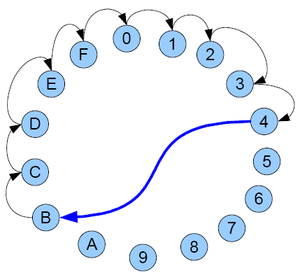Aiken code
| Aiken code | |
|---|---|
| Digits | 4[1][2] |
| Tracks | 4[1][2] |
| Digit values | 2 4 2 1[1][2] |
| Weight(s) | 0..4[1][2] |
| Continuity | no |
| Cyclic | no[1][2] |
| Minimum distance | 1[1][2] |
| Maximum distance | 4[1][2] |
| Redundancy | 0.7 |
| Lexicography | yes[1][2] |
| Complement | 9[1][2] |
The Aiken code (also known as 2421 code)[1][2] is a complementary binary-coded decimal (BCD) code. A group of four bits is assigned to the decimal digits from 0 to 9 according to the following table. The code was developed by Howard Hathaway Aiken and is still used today in digital clocks, pocket calculators and similar devices.
The Aiken code differs from the standard 8421 BCD code in that the Aiken code does not weight the fourth digit as 8 as with the standard BCD code but with 2.

The following weighting is obtained for the Aiken code: 2-4-2-1.
One might think that double codes are possible for a number, for example 1011 and 0101 could represent 5. However, here one makes sure that the digits 0 to 4 are mirror image complementary to the numbers 5 to 9.
| Aiken code | |||
|---|---|---|---|
| Decimal digit |
Aiken 2 4 2 1 code[1][2] | ||
| 0 | 0 0 0 0 | ||
| 1 | 0 0 0 1 | ||
| 2 | 0 0 1 0 | ||
| 3 | 0 0 1 1 | ||
| 4 | 0 1 0 0 | ||
| 5 | 1 0 1 1 | ||
| 6 | 1 1 0 0 | ||
| 7 | 1 1 0 1 | ||
| 8 | 1 1 1 0 | ||
| 9 | 1 1 1 1 | ||
See also
References
- 1 2 3 4 5 6 7 8 9 10 11 Steinbuch, Karl W., ed. (1962). Written at Karlsruhe, Germany. Taschenbuch der Nachrichtenverarbeitung (in German) (1 ed.). Berlin / Göttingen / New York: Springer-Verlag OHG. p. 71-74. LCCN 62-14511.
- 1 2 3 4 5 6 7 8 9 10 11 Steinbuch, Karl W.; Weber, Wolfgang; Heinemann, Traute, eds. (1974) [1967]. Taschenbuch der Informatik – Band II – Struktur und Programmierung von EDV-Systemen. Taschenbuch der Nachrichtenverarbeitung (in German). 2 (3 ed.). Berlin, Germany: Springer Verlag. pp. 98–100. ISBN 3-540-06241-6. LCCN 73-80607.
Further reading
- White, Garland S. (October 1953). "Coded Decimal Number Systems for Digital Computers". Proceedings of the IRE. 41 (10): 14450–1452. doi:10.1109/JRPROC.1953.274330. ISSN 0096-8390.